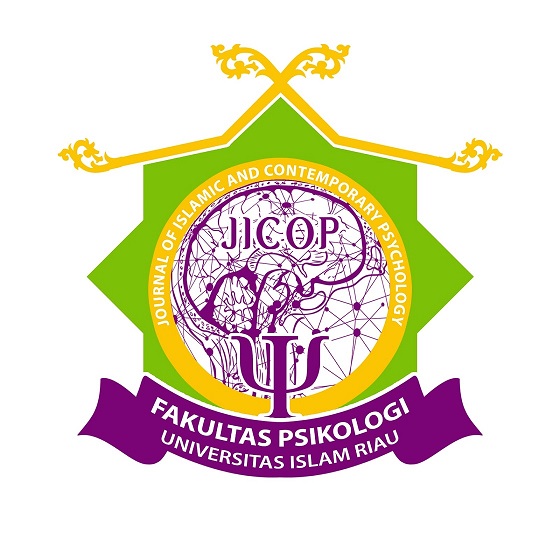Self-Instruction Training Untuk Meningkatkan Derajat Academic Buoyancy Mahasiswa
DOI:
https://doi.org/10.25299/jicop.v2i2.11544Keywords:
academic buoyancy, self-instruction training, studentsAbstract
This study aims to determine the effect of self-instruction training interventions in increasing the level of student academic buoyancy. Students need to have a high level of academic buoyancy in order to be able to overcome daily academic challenges and overcome the decline in academic self-regulation (Martin & Marsh, 2009). Students who have a low or moderate degree of academic buoyancy will have obstacles in overcoming daily academic challenges and academic setbacks. This condition causes low academic achievement that students have. In order to overcome this problem, this research examines whether self-instruction training interventions with CBT can help students increase their degree of academic buoyancy. This self-instruction technique is a behavior modification technique that has two uses, namely improving maladaptive mindsets, becoming positive mindsets, which are then used to direct individuals by giving positive instructions to themselves to make behavior changes to become more adaptive (Meichenbaum, in Martin & Pear 2015). This study uses a single subject design with AB research pattern. The participant of this study was a male student at the Faculty of Medicine, with a moderate degree of academic buoyancy. The results of the study show that the self-instruction training technique can increase the degree of academic buoyancy.
Downloads
References
Collie, R. J., Martin, A. J., Malmberg, L. A., Hall, J, & Ginns, P. (2015). Academic buoyancy, student achievement, and the linking role of control: A cross-lagged analysis of Australian high school students. British Journal of Educational Psychology, 85, 113-130.
Horner, R.H., Carr, E.G., Halle, G., Odom, S., Wolery, M., (2005). The Use of Single-Subject Research to Identify Evidence-Based Practice in Special Education. Journal of Exceptional Children, 71 (2).
Larasati, W. P. (2012). Meningkatkan Self-Esteem Melalui Metode Self-Instruction. (Thesis: tidak diterbitkan). Universitas Indonesia.
Martin, A. J. (2013). Academic buoyancy and academic resilience: Exploring 'everyday' and 'classic' resilience in the face of academic adversity. School Psychology International, 34, 488-500.
Martin, A. J., Marsh, Herbert. (2006). Daya apung akademik: Towards an understanding of students’ everyday academic resilience. Journal of Psychology, volume 46, nomor 1. Elsevier.
Martin, A. J., & Marsh, H. W. (2008a). Academic buoyancy: Towards an understanding of students’ everyday academic resilience. Journal of School Psychology, 46, 53-83
Martin, A. J., & Marsh, H. W. (2008b). Workplace and academic buoyancy: Psychometric assessment and construct validity amongst school personnel and students. Journal of Psychoeducational Assessment, 26, 168-184.
Martin, A. J., & Marsh, H. W. (2009). Academic resilience and academic buoyancy: Multidimensional and hierarchical conceptual framing of causes, correlates, and cognate constructs. Oxfords Review of Education, 35, 353-370.
Martin, A.J., & Burns, E.C. (2014). Academic buoyancy, resilience, and adaptability in students with ADHD. The ADHD Report, 22, 1-9.
Martin, A., Colmar, S., Davey, L., Marsh, H. (2010). Longitudinal modeling academic buoyancy and motivation: Do the '5Cs' hold up over time? British Journal of Educational Psychology, 80,473-496..
Martin, A.J. Papworth, B., Ginns, P., & Liem, G.A.D. (2014). Boarding school, motivation and engagement, and psychological well-being: A large-scale investigation. American Educational Research Journal.
Martin, G & Pear, J. (2015). Behavior Modification, What It Is and How To Do It, 10th Ed. Pearson Education International.
Martin, A. J., Yu, Kai., Ginns, P., & Papworth, B. (2016). Young people’s academic buoyancy and adaptability: A cross-cultural comparison of china with North America and United Kingdom. Journal of Educational Psychology. https://doi.org/10.1080/01443410.2016.1202904.
Mawarni, A. (2018). Strategi Bimbingan Kelompok dengan Teknik Pelatihan instruksi diri untuk Mengembangkan Daya apung akademik Siswa. (Thesis: tidak diterbitkan). Universitas Pendidikan Indonesia.
Sunanto, J., Takeuchi, K., Nakata, H. (2005). Pengantar Penelitian Dengan Subyek Tunggal. University of Tsukuba. Center for Research on International Cooperation in Educational Development.
Widiarini, A. D. (2018). Jadi Salah Satu Fokus Pembangunan, Apa Kabar Pendidikan Tinggi di Indonesia?. Dikutip dari https://edukasi.kompas.com
Downloads
Published
How to Cite
Issue
Section
License
This work is licensed under a Creative Commons Attribution - ShareAlike 4.0 International License (CC BY-SA)
This is an open-access article distributed under the terms of the Creative Commons Attribution-ShareAlike 4.0 International License which permits unrestricted use, distribution, and reproduction in any medium. Copyrights of all materials published in Journal of Islamic and Contemporary Psychology (JICOP) are freely available without charge to users or / institution. Users are allowed to read, download, copy, distribute, search, or link to full-text articles in this journal without asking by giving appropriate credit, provide a link to the license, and indicate if changes were made. All of the remix, transform, or build upon the material must distribute the contributions under the same license as the original.








